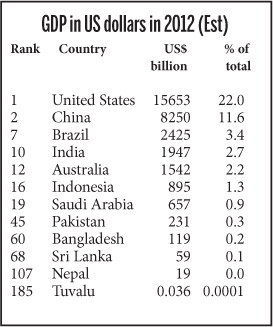GDP, GDP growth, GDP per capita, et al . . .
 Over the past two years the Government and the Central Bank of Sri
Lanka have made many endeavours to achieve the country's goal of
reaching a $ 4,000 per capita income, and to expand the economy to reach
a GDP of $100 billion. Over the past two years the Government and the Central Bank of Sri
Lanka have made many endeavours to achieve the country's goal of
reaching a $ 4,000 per capita income, and to expand the economy to reach
a GDP of $100 billion.
While it is laudable to have such targets so that that the entire
country could consciously aim at those, it must be noted that it also
provides the Opposition with some ammunition to derail the onward
journey, and to distract the economic players from being committed to
such targets.
One way in which the Opposition had attempted to cause distraction is
to challenge the fundamental concepts of measuring GDP per capita, and
to cast some doubt on the GDP per capita being a useful measure in a
country's tool-kit of indicators. In that light, it would be useful to
examine as to what these terms mean, how these are computed and what
relevance these numbers could have in fashioning the economic journey of
a nation.
 As all economists know, the nominal value of a country's total
production in a particular year is considered the current GDP. The
current GDP provides the basic monetary yardstick to value a country's
productive activities. However, as production is valued at prevailing
prices, a part of the increase in current GDP is due to inflation. As all economists know, the nominal value of a country's total
production in a particular year is considered the current GDP. The
current GDP provides the basic monetary yardstick to value a country's
productive activities. However, as production is valued at prevailing
prices, a part of the increase in current GDP is due to inflation.
Therefore, current GDP is always adjusted for inflation to obtain
constant GDP. Therefore, it is the constant GDP that is used for the
calculation of economic the growth rate of a country. In Sri Lanka too,
this standard practice is followed.
By dividing current GDP by the mid-year population, the per capita
GDP is obtained. This measure provides an estimate of the value of an
individual's average contribution to GDP. This is an average (or mean)
value and does not consider distributional aspects of income.
Further, since a country's GDP could increase (or decrease) due to
changes in population, GDP in per capita terms accounts for any such
change in population as well. Assuming equitable distribution, per
capita GDP also provides a measure of income at the prevailing prices,
which is easily understood by the public.
Dividing the current GDP by the average exchange rate gives a
country's GDP in US dollar terms. The purpose of this calculation is
different to measuring GDP in domestic currency, as current GDP in US
dollars enables across-country comparison. For instance, by comparing
current GDP in US dollars, each country's total economic strength could
be measured and each country's contribution to the global production can
also be evaluated.
The country ranking in terms of GDP in US dollars indicates that
populous countries in the world generally rank higher than countries
with smaller populations. Therefore, to measure the average contribution
of a resident of each country to its GDP, per capita GDP in US dollars
is a more suitable measure. For example, although China, Russia, India
and Indonesia belong to the 20 largest economies of the world, they are
not in the top 20 in per capita terms. It is also the per capita GDP in
US dollars that is used by major international agencies such as the IMF,
World Bank and the ADB to compare countries and classify them according
to income.
Further, assuming currency convertibility and free movement of goods
and services, current GDP per capita can be considered as a common
medium, and can therefore be used as a common measure of the ability to
purchase goods and services anywhere in the world.
It must also be noted that per capita GDP in US dollar terms is not
used to measure a country's GDP growth. That is because, as stated
earlier, this measure serves a specific purpose, which is to provide a
country comparison adjusted for population of each country. It must be
further noted that since the exchange rate movements closely reflect
inflation, especially in an open economy, dividing constant GDP by the
exchange rate would serve to discount the per capita contribution to GDP
twice.
That is why the global conversion of dividing current GDP by the
exchange rate is the measure used for comparison across nations. It must
be emphasised that the purpose of computing per capita GDP does not
measure income inequality. Several other yardsticks such as the Gini
coefficient and Lorenz curve are used for that purpose. However, both
redistribution and economic growth are known to reduce poverty and
uplift the livings standards of people in general. In that context,
while there is a chance for inequality to rise at early stages of
take-off, it is undeniable that economic growth in general terms,
benefits the greater population through trickle down effects and by
making available a larger pie to be shared amongst the population of a
country.
Targeting per capita GDP to exceed $ 4,000 by 2016 reflects the Sri
Lankan policymakers' desire to reach the level of upper middle income
category as per the classification of international agencies. This is
only one aspect of the policy mix, and other aspects such as aiming to
reduce poverty, unemployment, malnutrition, and improve infrastructure
facilities would no doubt address distributional issues effectively.
Several other measures of GDP such as income adjusted for purchasing
power parity, per person employed, per unit of energy use exist to serve
different purposes, and are also popularly used. No doubt, these
measures too, could be meaningful in explaining a given situation.
|



